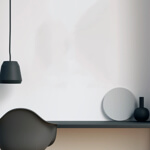Eduardo Paolozzi 1924-2005
Hermes des Praxiteles, 1947
Collage with coloured pencil and wash
26.5 x 18.4 cms
10 6/16 x 7 3/16 ins
10 6/16 x 7 3/16 ins
234
Sold
Paolozzi's Hermes des Praxiteles (1947) embodies the past, the present and the future of Western man: the ideal of a classical marble torso, the contemporary reality of flesh and blood...
Paolozzi's Hermes des Praxiteles (1947) embodies the past, the present and the future of Western man: the ideal of a classical marble torso, the contemporary reality of flesh and blood and the mechanical future of the cyborg. However, the limbs of the classical torso are broken, the machine has no apparent function and the figure is covered in bodily stains.
In such works Paolozzi may have been inspired by such Surrealist precursors as Max Ernst's collage novel, Une Semaine de Bonté, which he admired, but he replaced the surrealist's unfolding psychosexual dramas with a focus on the treatment of the body that eschewed individualisation and dispensed with narrative. It is the survival of the classical torso as well as its fragmentation that is crucial to the artist:
'In normal society something which is broken is regarded as flawed but to an artist it is an enchantment. In museums one seldom sees Greek sculpture intact. You see fragments which are left ... Scholars decipher whole civilisations through their remains.' Eduardo Paolozzi, quoted in Judith Collins, Eduardo Paolozzi: works on paper 1946-1995, 1996.
By allowing for the coexistence of the Greek statue with machine parts Paolozzi suggests a comparable signification: it will be the fragments of machines, not of statues, by which our own culture will be recaptured.
In such works Paolozzi may have been inspired by such Surrealist precursors as Max Ernst's collage novel, Une Semaine de Bonté, which he admired, but he replaced the surrealist's unfolding psychosexual dramas with a focus on the treatment of the body that eschewed individualisation and dispensed with narrative. It is the survival of the classical torso as well as its fragmentation that is crucial to the artist:
'In normal society something which is broken is regarded as flawed but to an artist it is an enchantment. In museums one seldom sees Greek sculpture intact. You see fragments which are left ... Scholars decipher whole civilisations through their remains.' Eduardo Paolozzi, quoted in Judith Collins, Eduardo Paolozzi: works on paper 1946-1995, 1996.
By allowing for the coexistence of the Greek statue with machine parts Paolozzi suggests a comparable signification: it will be the fragments of machines, not of statues, by which our own culture will be recaptured.
Exhibitions
Eduardo Paolozzi. Artificial Horizons and Eccentric Ladders. Works on Paper 1946-1995, British Council, 1996, (cat. 8)Henry Moore and the Geometry of Fear, James Hyman Gallery, 19 November 2002 - 18 January 2003, (cat. 23)
Literature
Judith Collins, Eduardo Paolozzi: Artificial Horizons and Eccentric Ladders: Works on Paper 1946 - 1995, British Council, 1996, pp 16 - 17, (cat. 8), illustrated p.42.Judith Collins, Eduardo Paolozzi: works on paper 1946-1995, 1996Twentieth-century British Art, James Hyman Gallery, London, 2001, (cat. 8), illustrated p. 19.Henry Moore and the Geometry of Fear, James Hyman Gallery, London, 2002, (cat. 23), illustrated p.41.
Join our mailing list
* denotes required fields
We will process the personal data you have supplied to communicate with you in accordance with our Privacy Policy. You can unsubscribe or change your preferences at any time by clicking the link in our emails.




